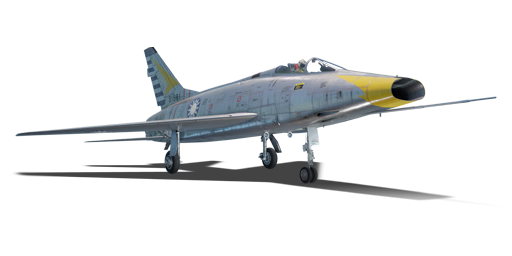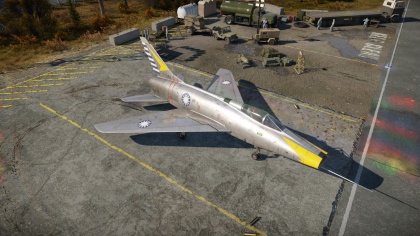F-100A (China)
Contents
Description
The ␗F-100A Super Sabre is a rank VI Chinese jet fighter
with a battle rating of 9.7 (AB/SB) and 9.3 (RB). It was introduced in Update 1.97 "Viking Fury".
The first supersonic jet available in the ROCAF fighter line of the China tree, the F-100A is an early variant of the famous "Super Sabre", though in Taiwanese service it received a number of upgrades to bring it up to par with later models. Compared to the fighter-bomber F-100D, it has a smaller wing with a straight trailing edge, fewer hardpoints, and no flaps. It also has an early J57P7 engine that produces less thrust than the D model's J57P21. The speed and acceleration remain comparable since the F-100A is a few tons lighter.
The F-100A's handling generally feels lighter than the F-100D and it enjoys a better roll rate, though the lack of flaps impacts low speed maneuverability. The weapons selection is definitely inferior: while it can still carry goodies like the AGM-12B Bullpup and the AIM-9B Sidewinder, its bomb selection is far more limited, unguided rockets are unavailable, and it lacks access to the more advanced AIM-9E Sidewinder. The lower battle rating makes up for these faults and if flown well the F-100A will only face serious competition from fellow supersonics like the French F-100D and the English Electric Lightning.
General info
Flight performance
Describe how the aircraft behaves in the air. Speed, manoeuvrability, acceleration and allowable loads - these are the most important characteristics of the vehicle.
| Characteristics | Max Speed (km/h at 10,671 m) |
Max altitude (metres) |
Turn time (seconds) |
Rate of climb (metres/second) |
Take-off run (metres) | |||
|---|---|---|---|---|---|---|---|---|
| AB | RB | AB | RB | AB | RB | |||
| Stock | 1,357 | 1,349 | 15240 | 29.5 | 30.3 | 104.7 | 93.2 | 900 |
| Upgraded | ___ | ___ | __._ | __._ | __._ | __._ | ||
Details
| Features | |||||
|---|---|---|---|---|---|
| Combat flaps | Take-off flaps | Landing flaps | Air brakes | Arrestor gear | Drogue chute |
| X | X | X | ✓ | X | ✓ |
| Limits | ||||||
|---|---|---|---|---|---|---|
| Wings (km/h) | Gear (km/h) | Flaps (km/h) | Max Static G | |||
| Combat | Take-off | Landing | + | - | ||
| 1361 | 447 | N/A | N/A | N/A | ~11 | ~4 |
| Optimal velocities (km/h) | |||
|---|---|---|---|
| Ailerons | Rudder | Elevators | Radiator |
| < 640 | < 540 | < 610 | N/A |
Engine performance
| Engine | Aircraft mass | ||||||
|---|---|---|---|---|---|---|---|
| Engine name | Number | Basic Mass | Wing loading (full fuel) | ||||
| Pratt & Whitney J57P7 | 1 | 9,079 kg | 315 kg/m2 | ||||
| Engine characteristics | Mass with fuel (no weapons load) | Max Takeoff Weight | |||||
| Weight (each) | Type | 9m fuel | 20m fuel | 30m fuel | 33m fuel | ||
| 900 kg | Afterburning axial-flow turbojet | 9,677 kg | 10,408 kg | 11,073 kg | 11,273 kg | 13,141 kg | |
| Maximum engine thrust @ 0 m (RB / SB) | Thrust to weight ratio @ 0 m (WEP) | ||||||
| Condition | 100% | WEP | 9m fuel | 20m fuel | 30m fuel | 33m fuel | MTOW |
| Stationary | 3,383 kgf | 5,616 kgf | 0.58 | 0.54 | 0.51 | 0.50 | 0.43 |
| Optimal | 4,004 kgf (1,200 km/h) |
8,056 kgf (1,200 km/h) |
0.83 | 0.77 | 0.73 | 0.71 | 0.61 |
Survivability and armour
Examine the survivability of the aircraft. Note how vulnerable the structure is and how secure the pilot is, whether the fuel tanks are armoured, etc. Describe the armour, if there is any, and also mention the vulnerability of other critical aircraft systems.
Armaments
Offensive armament
Describe the offensive armament of the aircraft, if any. Describe how effective the cannons and machine guns are in a battle, and also what belts or drums are better to use. If there is no offensive weaponry, delete this subsection.
Suspended armament
Describe the aircraft's suspended armament: additional cannons under the wings, bombs, rockets and torpedoes. This section is especially important for bombers and attackers. If there is no suspended weaponry remove this subsection.
Defensive armament
Defensive armament with turret machine guns or cannons, crewed by gunners. Examine the number of gunners and what belts or drums are better to use. If defensive weaponry is not available, remove this subsection.
Usage in battles
The F-100 is absolutely crippled in an up-tier situation. Unlike the F4 Phantom II or the MiG-21, the F-100 is equipped with leading-edge slats. This gives it a much higher angle of attack at low speeds, allowing the F-100 to out-turn both the F4 and the MiG-21 while pulling so many G-forces and dropping speed so severely that it becomes an easy kill for even AIM-9E missiles. However, at lower battle ratings, the F-100D is best at Boom & Zoom tactics. When fighting at a lower battle rating, the F-100 has some bad flying characteristics at low speeds which includes flying like a rock with wings. At high speeds, the F-100 locks up severely in spite of its all-flying tail and boosted controls, losing most of its control authority (particularly in its rolling axis). It has a massive angle of attack, so once you get on someone's tail, there's pretty much no escape, though floundering around at subsonic-optimized speeds leaves you vulnerable to interception. The best way to use the F-100D in the face of constant uptiers is to start climbing away from the battlefield, returning as support once more capable fighters have engaged the enemy. 5,000 meters is usually a good altitude to climb to. In the off chance that you encounter subsonic aircraft, Boom & Zoom tactics should be used to capitalize on your relatively superior climb rate. Climb high, make a pass, then climb away. Be extremely careful to not bleed energy and don't turn when subsonic planes are around, they will be able to outmanoeuvre the F-100D.
Against the F-100's second biggest foe (with the first being AIM-9Js and R-60s), the MiG-19, turning isn't a bad idea if you keep your energy up. You bleed a lot of speed in a turn, so extreme pulls aren't recommended, especially considering the MiG-19's superior maneuvering energy retention. The MiG-19 will rip easily at high speeds, something the F-100 doesn't have a problem with, though reaching those speeds effectively dooms the Super Sabre to degrees of maneuvering lockup similar to that experienced by its foe. However, the MiG-19 accelerates much faster than the F-100D at all speeds and altitudes so it can slip away easily. In the best-case scenario, bait the MiG-19 for a teammate, as the MiG-19 can't do much against two F-100s.
The F-100 is an amalgamation of paradoxical design features that results in an aircraft too heavy to sustain maneuvering engagements despite of its strong slats, too slow to accelerate to its surprisingly high rip speeds, and too sluggish at speed to take advantage of its strong armament, all while being near incapable of matching the performance demands of its BR-peers at 10.3. Overall to get this bus to perform, it must be at high speeds. Keep your energy up.
Modules
| Tier | Flight performance | Survivability | Weaponry | |||
|---|---|---|---|---|---|---|
| I | Fuselage repair | Compressor | M117 | |||
| II | New boosters | Airframe | Offensive 20 mm | AGM-12B Bullpup | ||
| III | Wings repair | Engine | M65 | |||
| IV | G-suit | Cover | New 20 mm cannons | AIM-9B | ||
Pros and cons
Summarise and briefly evaluate the vehicle in terms of its characteristics and combat effectiveness. Mark its pros and cons in the bulleted list. Try not to use more than 6 points for each of the characteristics. Avoid using categorical definitions such as "bad", "good" and the like - use substitutions with softer forms such as "inadequate" and "effective".
Pros:
Cons:
History
In the early Cold War era, the Republic of China Air Force was equipped with US jet aircraft like the F-86 Sabre and F-84 Thunderjet, which were used in clashes with the People's Republic of China over the Taiwan Straits. Amid growing conflict in 1958, a number of assorted F-100 Super Sabres were delivered to Taiwan, including the F-100A, the two-seat F-100F, and the reconnaissance RF-100A. The former were upgraded with a number of features from the latest F-100D, such as a taller vertical tail fin and wiring for Sidewinder missiles. Another batch of F-100s was delivered in the 1970s and the type remained in service until the 1980s.
The F-100 was not an easy aircraft to handle and several were lost in accidents. The details of their combat experiences are unclear. They may have fought with PLAAF jets but it is unknown if any kills or losses were scored. The RF-100As in particular were only used for about two years before being returned to the United States due to unsatisfactory capabilities and maintenance issues. The ROCAF was the only foreign user of the F-100A.
Media
Excellent additions to the article would be video guides, screenshots from the game, and photos.
See also
Links to the articles on the War Thunder Wiki that you think will be useful for the reader, for example:
- reference to the series of the aircraft;
- links to approximate analogues of other nations and research trees.
External links
Paste links to sources and external resources, such as:
- topic on the official game forum;
- encyclopedia page on the aircraft;
- other literature.
| North American Aviation | |
|---|---|
| Fighters | |
| P-51A | P-51 · P-51A |
| P-51C | P-51C-10 |
| P-51D | P-51D-5 · P-51D-10 · P-51D-20-NA · P-51D-30 |
| P-51H | P-51H-5-NA |
| Twin-engine fighters | F-82E |
| Jet fighters | F-86A-5 · F-86F-2 · F-86F-25 · F-86F-35 · F-100D |
| Strike aircraft | A-36 · PBJ-1H · PBJ-1J |
| FJ-4B · FJ-4B VMF-232 | |
| Bombers | B-25J-1 · B-25J-20 |
| Export/Licence | ▂B-25J-30 · ␗B-25J-30 |
| ▄Mustang Mk IA · F-6C-10-NA · ␗P-51C-11-NT · ␗P-51D-20 · J26 David · J26 · P-51D-20-NA · ␗P-51K | |
| F-86F-30 ▅ · ␗F-86F-30 · F-86F-40 ▅ · F-86F-40 JASDF▅ · ␗F-86F-40 | |
| ◄F-86K · ▄F-86K (Italy) · ▄F-86K (France) | |
| ␗F-100A · ▄F-100D · ␗F-100F | |
| Captured | ▅P-51C-11-NT |
| Canadair Limited license-built the F-86 as the CL-13 for use in Canada and export to Europe. | |
| Fiat license-built the F-86K for the Italian Air Force though another 120 NAA built F-86Ks were also sold to the Italians. | |
| See Also | Mitsubishi Heavy Industries · Canadair Limited · Fiat Aviation |
| China jet aircraft | |
|---|---|
| Fighters | J-2 · J-4 · J-6A · J-7II · J-7D · J-7E · J-8B · J-8F · J-10A · J-11 · J-11A |
| Strike aircraft | Q-5 early · Q-5A · Q-5L · JH-7A |
| Bombers | H-5 |
| France | ␗Mirage 2000-5Ei |
| USA | ␗F-84G-21-RE · ␗F-84G-31-RE · ␗F-86F-30 · ␗F-86F-40 · ␗F-100A · ␗F-100F · ␗F-104A · ␗F-104G · ␗F-5A · ␗F-5E · ␗F-16A MLU |
| USSR | ␗MiG-9 · ␗MiG-9 (l) |
| North Korea | Shenyang F-5 |
| Pakistan | A-5C · JF-17 |





